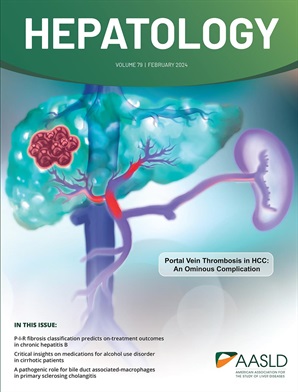il - 1β信号介导乙型和丙型肝炎病毒相互作用
IF 15.8
1区 医学
Q1 GASTROENTEROLOGY & HEPATOLOGY
引用次数: 0
摘要
背景和目的乙型肝炎病毒(HBV)和丙型肝炎病毒(HCV)共享传播途径,经常同时感染肝脏,导致肝脏疾病加速进展。在直接作用抗病毒药物(DAAs)治疗HCV的时代,HCV治愈后HBV再激活的报道使合并感染的临床影响进一步复杂化。虽然已知hcv诱导的干扰素(IFN)反应可抑制HBV,但其潜在机制仍不完全清楚。本研究旨在探讨HCV如何在合并感染的情况下调节HBV感染,并确定HCV清除后预防HBV再激活的策略。方法和结果我们使用了一个由人诱导多能干细胞(hiPSC)来源的肝细胞、肝星状细胞和巨噬细胞组成的多细胞肝培养模型,该模型支持HBV和HCV的生产感染,并概括了临床共感染动力学。我们发现来自hcv活化巨噬细胞的il - 1β可独立于IFN信号抑制HBV复制。从机制上讲,il - 1β通过诱导截断的C/EBPβ亚型下调肝细胞中的HBV受体SLC10A1,该亚型负调控全长变体。同时,il - 1β通过USF1磷酸化诱导ISG20表达,进一步抑制HBV复制。DAAs和HBV进入抑制剂的联合治疗有效地阻止了模型中HBV的再激活。结论我们的研究结果揭示了HCV通过il - 1β介导的巨噬细胞来源的、不依赖ifn的抑制HBV感染的机制。这些发现强调了在合并感染过程中嗜肝病毒之间的复杂串扰,并表明靶向il - 1β调节的途径可能为预防daa治疗患者的HBV再激活提供治疗潜力。本文章由计算机程序翻译,如有差异,请以英文原文为准。
IL1β Signaling Mediates the Interaction Between Hepatitis B and C Viruses.
BACKGROUND AND AIMS
Hepatitis B virus (HBV) and hepatitis C virus (HCV) share transmission routes and often coinfect the liver, leading to accelerated liver disease progression. In the era of direct-acting antivirals (DAAs) for HCV, the clinical impact of coinfection is further complicated by reports of HBV reactivation following HCV cure. While HCV-induced interferon (IFN) responses are known to suppress HBV, the underlying mechanisms remain incompletely understood. This study aimed to investigate how HCV modulates HBV infection in the setting of coinfection and to identify strategies to prevent HBV reactivation post-HCV clearance.
APPROACH AND RESULTS
We utilized a multicellular liver culture model composed of human-induced pluripotent stem cell (hiPSC)-derived hepatocytes, hepatic stellate cells, and macrophages, which supports productive HBV and HCV infection and recapitulates clinical coinfection dynamics. We found that IL1β derived from HCV-activated macrophage suppresses HBV replication independent of IFN signaling. Mechanistically, IL1β downregulated the HBV receptor SLC10A1 in hepatocytes via induction of a truncated C/EBPβ isoform that negatively regulates the full-length variant. Concurrently, IL1β induced ISG20 expression through USF1 phosphorylation, further inhibiting HBV replication. A combination treatment of DAAs and an HBV entry inhibitor effectively prevented HBV reactivation in the model.
CONCLUSIONS
Our findings reveal a macrophage-derived, IFN-independent mechanism by which HCV suppresses HBV infection, mediated through IL1β. These insights highlight the complex crosstalk between hepatotropic viruses during coinfection and suggest that targeting IL1β-regulated pathways may offer therapeutic potential to prevent HBV reactivation in DAA-treated patients.
求助全文
通过发布文献求助,成功后即可免费获取论文全文。
去求助
来源期刊

Hepatology
医学-胃肠肝病学
CiteScore
27.50
自引率
3.70%
发文量
609
审稿时长
1 months
期刊介绍:
HEPATOLOGY is recognized as the leading publication in the field of liver disease. It features original, peer-reviewed articles covering various aspects of liver structure, function, and disease. The journal's distinguished Editorial Board carefully selects the best articles each month, focusing on topics including immunology, chronic hepatitis, viral hepatitis, cirrhosis, genetic and metabolic liver diseases, liver cancer, and drug metabolism.
 求助内容:
求助内容: 应助结果提醒方式:
应助结果提醒方式:


